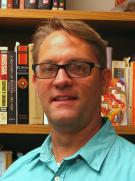
Christopher Ely
Associate Professor of History, Florida Atlantic University
When did you first develop an interest in Slavic, East European and Eurasian Studies?
I first grew interested in Slavic Studies when I was an undergraduate in the early 1980s. As Ronald Reagan’s “Evil Empire” rhetoric heated up, it seemed to me that one of the best things a person could contribute at that time would be simply to learn more about the so-called enemy. Around that same time I took a class on the novels of Dostoevskii and another on 19th century Russian intellectual history. I got to write about Belinskii, Chernyshevskii, Turgenev and the “Mighty Handful” Composers. I’ve been a 19th century specialist ever since.
How have your interests changed since then?
When I started graduate school, my Russian language skills were still poor, so I began by writing about painting as a way to ease the research burden. 
What is your current research project?
My current project, tentatively titled “Invisible Force: Radical Populism, Urban Space and the Rise of the Revolutionary Underground in Reform-Era Russia,” rejects the view that the radical populist movement of the 1860s and 70s was exclusively driven by ideological principles. It instead emphasizes the ways in which populism developed a disciplined and tightly organized underground movement in a dialectical process involving state oppression and the creation of methods by which to escape that oppression. In turn, in my view, underground space and its tactical advantages drove the movement toward more and more extreme measures, eventually resulting in the use of violence and hence the creation of what was, by and large, the first modern terrorist movement. Almost by accident, the populists created a method of urban insurrection that was a highly effective means of gaining attention, though as with later movements that relied on terrorism, it was never in a position to capitalize on its revolutionary aims.
What do you value about your ASEEES membership?
I have belonged to the ASEEES since I was a graduate student in the early 1990s. Without the articles in Slavic Review, the primary annual conference in our field, the newsletter, and all the connections I have made, I really can’t imagine how I would have made my way in this profession.
Besides your professional work, what other interests and/or hobbies do you enjoy?
As for outside interests, from the days of my work on nature I’m still an outdoors enthusiast and love kayaking, body-surfing, bird-watching, deep sea fishing, shell-collecting and hunting for fossils. I also play the guitar and love to travel for pleasure.